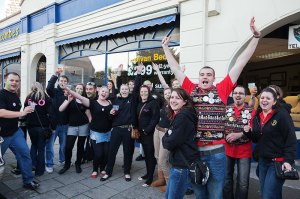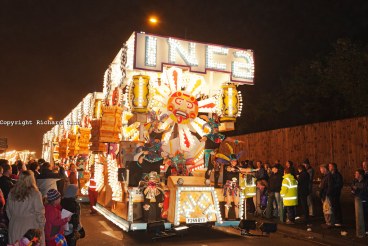It’s almost twelve years now, since I moved to live and work in Oslo, the capital city of Norway. It was probably on my way back from my first return home after the move, that I got chatting to one of the other passengers. I remember remarking that I’d like to see the Northern Lights, without really giving it too much thought. He of course said that it would have to be a winter trip, which had I thought about it, was pretty obvious really. Although I did see something while walking home from work late once in the early hours, I never really got the chance, as the contract had to end earlier than expected.
 A couple of weeks ago, I finally got my chance. I only arrived back on Monday, in the early hours, so the photos are only just ready, but I was able to spend six days in Tromsø, in the far north. Because it’s so far north of the arctic circle, the sun doesn’t rise for almost two months, giving a strange pale blue light (when it’s clear) during the day. At this time of year in early December, it lasts for around two hours.
A couple of weeks ago, I finally got my chance. I only arrived back on Monday, in the early hours, so the photos are only just ready, but I was able to spend six days in Tromsø, in the far north. Because it’s so far north of the arctic circle, the sun doesn’t rise for almost two months, giving a strange pale blue light (when it’s clear) during the day. At this time of year in early December, it lasts for around two hours.
 Unfortunately however, we arrived to rain and strong winds, which pretty much lasted for the first four days. The chances of seeing the lights didn’t look too promising, but by the thursday, the day that had been booked, the forecast was for clearing skies. Just as we left though, the weather suddenly took a turn for the worse again, with a heavy downpour. Not in the slightest bit perturbed though, our guide headed east, towards the Finnish border, where the weather should be clearer, due to the shelter of the mountains. We had booked our trip with Kjetil Skogli, the man who took out Joanna Lumley during a British television production a few years ago. When I mentioned in the Visit Tromsø information office who I’d booked with, the response was “He’s the expert, you’ll definitely see them”, which was encouraging. Our first stop was just over an hour away from Tromsø and the skies looked a lot clearer, with increasing glimpses of the moon. As we came off the main road near Seljelvenes, towards the northeast, the sky looked to be glowing. After waiting for some time, the glow came closer, eventually forming distinct bands of white, against the dark sky. Light pollution was non-existent, allowing the best views of the stars and the moon was behind us, well away from the aurora that was forming.
Unfortunately however, we arrived to rain and strong winds, which pretty much lasted for the first four days. The chances of seeing the lights didn’t look too promising, but by the thursday, the day that had been booked, the forecast was for clearing skies. Just as we left though, the weather suddenly took a turn for the worse again, with a heavy downpour. Not in the slightest bit perturbed though, our guide headed east, towards the Finnish border, where the weather should be clearer, due to the shelter of the mountains. We had booked our trip with Kjetil Skogli, the man who took out Joanna Lumley during a British television production a few years ago. When I mentioned in the Visit Tromsø information office who I’d booked with, the response was “He’s the expert, you’ll definitely see them”, which was encouraging. Our first stop was just over an hour away from Tromsø and the skies looked a lot clearer, with increasing glimpses of the moon. As we came off the main road near Seljelvenes, towards the northeast, the sky looked to be glowing. After waiting for some time, the glow came closer, eventually forming distinct bands of white, against the dark sky. Light pollution was non-existent, allowing the best views of the stars and the moon was behind us, well away from the aurora that was forming.
While the display wasn’t the best, as solar activity had been low since the beginning of October, it was certainly an experience. They didn’t quite look as I’d imagined though. You see all the photos and imagine that the aurorae will be a mass of greens and reds, perhaps mixed in with some purples and blues if you’re lucky, but they were essentially white. I could just about make out some red colouration, but the greens just weren’t visible with the naked eye. Of course, again, had I thought more about it, I would have remembered that the human eye is pretty poor at distinguishing colour in the dark. Some people have better colour perception in the dark than others and one of the others could make out a slight green tinge. Had the display been stronger, then there would have been a greater chance of seeing the colours, but I was able to get a couple of useable photographs. Judging by my settings and comparing them to other photos, I would estimate, that a strong display could have been as much as ten times brighter. It wasn’t long before the skies clouded over again though and each of the subsequent stops failed to reveal any better displays before the clouds caught up with us.
 Mildly satisfied that I’d at least seen them, I now hoped for clearer skies during the day, so that I could photograph Tromsø in the best light possible. Friday was a complete washout though with heavy rain and more strong winds, which later turned to sleet with occasional snow flurries, resulting in a spattering of snow on Friday night. Saturday was another story however. The skies cleared, with much colder weather, resulting in some of the best light I’ve ever seen for photography. It’s difficult to describe, but the closest I can come, is by describing it as a turquise blue light, tinged with pinks and purples, as the invisible sun reflects off the few clouds. As dusk approaches in the afternoon, the colour darkens to give an even stranger, almost surreal light.
Mildly satisfied that I’d at least seen them, I now hoped for clearer skies during the day, so that I could photograph Tromsø in the best light possible. Friday was a complete washout though with heavy rain and more strong winds, which later turned to sleet with occasional snow flurries, resulting in a spattering of snow on Friday night. Saturday was another story however. The skies cleared, with much colder weather, resulting in some of the best light I’ve ever seen for photography. It’s difficult to describe, but the closest I can come, is by describing it as a turquise blue light, tinged with pinks and purples, as the invisible sun reflects off the few clouds. As dusk approaches in the afternoon, the colour darkens to give an even stranger, almost surreal light.
All in all, my trip to northern Norway was a success, but I know want to try seeing a stronger display and especially perfect my technique of photographing the Northern Lights, which left a bit to be desired.

 Last Sunday, I decided it was about time I went out again. The lighting was pretty much perfect for some shots I had been planning for almost two years, but had always found somewhere else to photograph. A few miles outside of central Bridgwater, the Bridgwater and Taunton Canal passes a pub called the Boat and Anchor Inn, near the Huntworth Business Park. It isn’t anything out of the ordinary as far as canal-side pubs go, but they do serve very good food and of course offer nice beer. I didn’t visit on this occasion though, as I wanted to catch the low sunlight lighting the pub buildings and the canal. However, my memory was a little faulty and the angle I was looking for wasn’t possible, so I concentrated more on the canal, where the light was ideal.
Last Sunday, I decided it was about time I went out again. The lighting was pretty much perfect for some shots I had been planning for almost two years, but had always found somewhere else to photograph. A few miles outside of central Bridgwater, the Bridgwater and Taunton Canal passes a pub called the Boat and Anchor Inn, near the Huntworth Business Park. It isn’t anything out of the ordinary as far as canal-side pubs go, but they do serve very good food and of course offer nice beer. I didn’t visit on this occasion though, as I wanted to catch the low sunlight lighting the pub buildings and the canal. However, my memory was a little faulty and the angle I was looking for wasn’t possible, so I concentrated more on the canal, where the light was ideal. While I was photographing the first of my chosen views, a dog walker stopped to say hello and mentioned that they were showing the canal on Countryfile on BBC1 later that evening. We chatted for a while, with him stating that he hadn’t seen them filming, but I thought it was slightly ironic, that I’d chosen that evening to photograph the canal.
While I was photographing the first of my chosen views, a dog walker stopped to say hello and mentioned that they were showing the canal on Countryfile on BBC1 later that evening. We chatted for a while, with him stating that he hadn’t seen them filming, but I thought it was slightly ironic, that I’d chosen that evening to photograph the canal.







 As I mentioned in my last blog post, I got caught up in the Black Sunday celebrations that are held every year on the Sunday following Bridgwater Carnival. I had originally planned to try out a new lens, ready for an upcoming Norway trip, but with the weekend travel problems in Somerset, I decided it wasn’t worth trying to drive anywhere, so I wandered down to Bridgwater Quay, before walking along the river to the centre.
As I mentioned in my last blog post, I got caught up in the Black Sunday celebrations that are held every year on the Sunday following Bridgwater Carnival. I had originally planned to try out a new lens, ready for an upcoming Norway trip, but with the weekend travel problems in Somerset, I decided it wasn’t worth trying to drive anywhere, so I wandered down to Bridgwater Quay, before walking along the river to the centre. As I was walking up through St Mary Street, I was approached by a large boisterous group, it was Black Sunday after all, so I couldn’t really expect anything else. Anyway, after a quick chat and change of lens, I took a couple of photographs. I promised to send the images to one of the group, but unfortunately, the e-mail address I wrote down, doesn’t seem to work. If anyone from Wick or Pentathlon Carnival Clubs remembers having their photo taken, then please contact me and I will forward on the promised photos.
As I was walking up through St Mary Street, I was approached by a large boisterous group, it was Black Sunday after all, so I couldn’t really expect anything else. Anyway, after a quick chat and change of lens, I took a couple of photographs. I promised to send the images to one of the group, but unfortunately, the e-mail address I wrote down, doesn’t seem to work. If anyone from Wick or Pentathlon Carnival Clubs remembers having their photo taken, then please contact me and I will forward on the promised photos.









